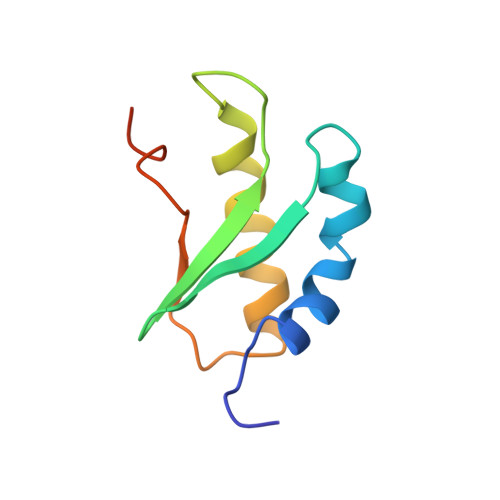The cooperative role of OsCnfU-1A domain I and domain II in the iron sulphur cluster transfer process as revealed by NMR
Saio, T., Kumeta, H., Ogura, K., Yokochi, M., Asayama, M., Katoh, S., Katoh, E., Teshima, K., Inagaki, F.(2007) J Biochem 142: 113-121
- PubMed: 17545250
- DOI: https://doi.org/10.1093/jb/mvm120
- Primary Citation of Related Structures:
2JNV - PubMed Abstract:
OsCnfU-1A is a chloroplast-type Nfu-like protein that consists of tandem repeats sharing high sequence homology. Domain I of this protein, but not domain II, has a C-X-X-C motif that is thought to assemble an iron-sulphur cluster. Herein we report the solution structure of OsCnfU-1A domain I (73-153). Although OsCnfU-1A domain I is structurally similar to OsCnfU-1A domain II (154-226), the electrostatic surface potential of the 2 domains differs. Domain I has an acidic surface, whereas that of domain II is predominantly basic. Chemical shift perturbation studies on OsCnfU-1A domain I and domain II with ferredoxin revealed negligible chemical shift changes in domain I, whereas much larger chemical shift changes were observed in domain II. The residues with larger chemical shift changes were located on the basic surface of domain II. Considering that ferredoxin is predominantly negatively charged, we propose the following hypothesis: First, an iron-sulphur cluster is assembled on domain I. Next, domain II interacts with the ferredoxin, thus tethering domain I close to the ferredoxin. Finally, domain I transfers the iron-sulphur cluster to the ferredoxin. Thus, domain II facilitates the efficient transfer of the iron-sulphur cluster from domain I to the ferredoxin.
Organizational Affiliation:
Laboratory of Structural Biology, Graduate School of Pharmaceutical Science, Hokkaido University, Sapporo, Hokkaido, Japan.














